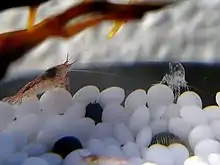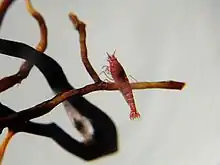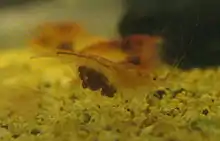| Halocaridina rubra | |
|---|---|
 | |
| Ovigerous ʻōpaeʻula | |
| Scientific classification | |
| Domain: | Eukaryota |
| Kingdom: | Animalia |
| Phylum: | Arthropoda |
| Class: | Malacostraca |
| Order: | Decapoda |
| Suborder: | Pleocyemata |
| Infraorder: | Caridea |
| Family: | Atyidae |
| Genus: | Halocaridina |
| Species: | H. rubra |
| Binomial name | |
| Halocaridina rubra Holthuis, 1963 | |
Halocaridina rubra, the Hawaiian red shrimp or volcano shrimp is a small red shrimp of the family Atyidae, with the common Hawaiian name ʻōpaeʻula (meaning "red shrimp").[1]
Description and distribution
It is a small red shrimp, rarely longer than 1.5 cm (0.6 in) in length, typically found in brackish water pools near the sea shore, sometimes in large numbers. Such pools are referred to as anchialine pools (from the Greek anchialos = near the sea). Halocaridina rubra is endemic to the Hawaiian islands, and most commonly found in anchialine pools in fresh lava substrates on Hawaiʻi and Maui Island; it has also been found in limestone karst pools and hypogeal habitats in limestone on older islands, such as Oʻahu. Its habitat is unique and sparsely represented on five of the eight high Hawaiian Islands (Maui, Kahoʻolawe, Oʻahu, Molokaʻi and Hawaiʻi).[1]
Ecology
ʻŌpaeʻula are herbivorous and detritivorous shrimp occupying both hypogeal (subterranean) and epigeal (surface) anchialine waters. Typical food of ʻōpaeʻula is algal and bacterial mats on the surface of rocks and other substrates in anchialine pools. Chelipeds are adapted for scraping and filtering of algal-bacterial layers.[1] Serrated setae scrape the substrate surface, and filamentous setae collect the loosened food materials. The latter can also act as filters for filter feeding during phytoplankton blooms.[1] The grazing activity of this shrimp is essential in maintaining the integrity of the crust, an actively growing matrix of plants, bacteria, diatoms, protozoans, and underlying siliceous and carbonate materials. Halocaridina is well adapted to the epigeal-hypogeal habitat in the pools. It reproduces in the subterranean portion of the habitat.[1]
Aquaria
Recent popularity of ʻōpaeʻula as a low-maintenance pet in Hawaiʻi and elsewhere has brought this otherwise obscure decapod crustacean into popular consciousness. A long-lived species, ʻōpaeʻula have been known to live for as long as 20 years in captivity. Sexes are difficult to distinguish, except when gravid females carry clusters of red/maroon eggs under their pleopods. Early larvae are planktonic filter-feeders.
They occasionally molt their shells, which can be seen as silvery exoskeletons at the bottom of the tank. There may be some evidence that ʻōpaeʻula mate after molting, or that molting and mating may be related.[2]
Stressed ʻōpaeʻula tend to hide, though if given plenty of places to hide they are more likely to venture into open spaces.[2] ʻŌpaeʻula are social creatures and are rarely seen fighting, in fact when unstressed they often cluster together while eating or sunbathing. Shrimp in tanks can also be seen cleaning themselves or swimming slow laps.
The shrimp was the animal featured in the Ecosphere closed-system aquarium.
 Halocaridina rubra kept as a pet in an EcoSphere aquarium |
 Halocaridina rubra shrimp (left) and part of an exoskeleton |
 Halocaridina rubra shrimp carrying eggs |
References
- 1 2 3 4 5 Julie H. Bailey-Brock & Richard E. Brock (1993). "Feeding, reproduction, and sense organs of the Hawaiian anchialine shrimp Halocaridina rubra (Atyidae)". Pacific Science. 47 (4): 338–355. hdl:10125/2024.
- 1 2 "The Amazing Creature!". www.fukubonsai.com. Retrieved 2015-12-16.
Further reading
- Scott R. Santos (2006). "Patterns of genetic connectivity among anchialine habitats: a case study of the endemic Hawaiian shrimp Halocaridina rubra on the island of Hawaii" (PDF). Molecular Ecology. 15 (10): 2699–2718. doi:10.1111/j.1365-294X.2006.02965.x. PMID 16911195. S2CID 25660112.
- Jennifer L. Ivey & Scott R. Santos (2007). "The complete mitochondrial genome of the Hawaiian anchialine shrimp Halocaridina rubra Holthuis, 1963 (Crustacea: Decapoda: Atyidae)". Gene. 394 (1–2): 35–44. doi:10.1016/j.gene.2007.01.009. PMID 17317038.